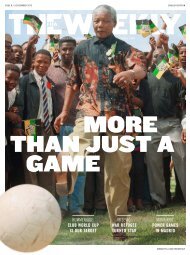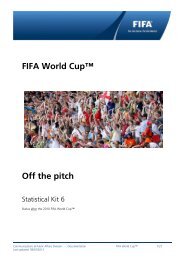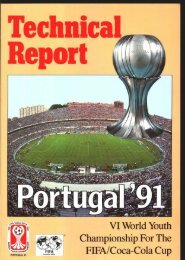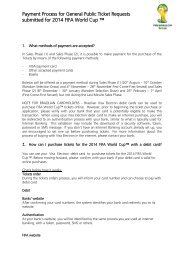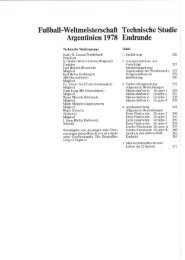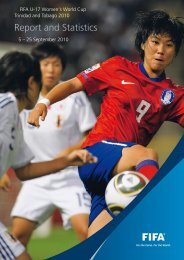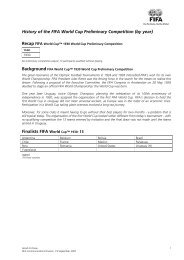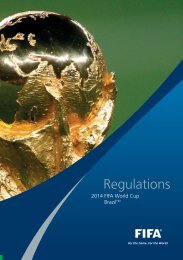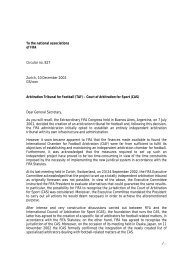Report and Statistics - FIFA.com
Report and Statistics - FIFA.com
Report and Statistics - FIFA.com
You also want an ePaper? Increase the reach of your titles
YUMPU automatically turns print PDFs into web optimized ePapers that Google loves.
10<br />
Overall Analysis<br />
Technical <strong>and</strong> Tactical Analysis<br />
Performance – potential top-class<br />
international players<br />
From the very start of this tournament it<br />
was clear that this would be another strong<br />
positive step in the development of women’s<br />
football.<br />
After seeing the performance of the teams,<br />
we can conclude that there are many skilful<br />
individual players who have the potential to<br />
be major international top-class players at the<br />
senior level. The All-Star Team features just<br />
some of them.<br />
Compared to the 2004 event, there were<br />
more skilful individual players on each team<br />
in 2006, <strong>and</strong> in general, the teams were more<br />
balanced than before.<br />
The st<strong>and</strong>ard of fi tness is also improving but<br />
there is still room for more improvement for<br />
some teams if they want to match the top<br />
teams, who boast more players with pace.<br />
The best teams also have the ability to play at<br />
pace for the whole game <strong>and</strong> for the entire<br />
tournament.<br />
Although the performances of the teams<br />
<strong>and</strong> players are not yet totally consistent,<br />
there were more inconsistent performances<br />
in the group stages than in the fi nal matches.<br />
We have to take into consideration the fact<br />
that these players are young <strong>and</strong> that there<br />
were signifi cant differences in terms of the<br />
players’ ages.<br />
But nevertheless, it was obvious that the<br />
teams <strong>and</strong> players who had longer preparation<br />
time <strong>and</strong> played together as a team gave<br />
more solid performances. The four teams in<br />
the semi-fi nals (Brazil, Korea DPR, China PR<br />
<strong>and</strong> USA) were good examples of this.<br />
To perform well in big games, the team, the<br />
players themselves, the coaches <strong>and</strong> all other<br />
team offi cials must be prepared.<br />
Flexibility in using own strengths<br />
Overall, teams in this <strong>com</strong>petition are more<br />
balanced now.<br />
When it came to fl exibility in using their own<br />
strengths <strong>and</strong> qualities to win the game <strong>and</strong><br />
being able to change the team organisation to<br />
adapt to the strengths or weaknesses of their<br />
opponents, lack of experience <strong>and</strong> underst<strong>and</strong>ing<br />
of the game in some teams became evident.<br />
Therefore, preparation, the importance<br />
of playing in big games <strong>and</strong> <strong>com</strong>peting against<br />
different styles of football is crucial to developing<br />
future top-class international players.<br />
It also helps to encourage more players to<br />
take responsibility <strong>and</strong> show leadership on<br />
the pitch <strong>and</strong>, of course, off it. This will be a<br />
big challenge for many coaches, players <strong>and</strong><br />
teams in the future.<br />
In this tournament, many teams played a different<br />
style of football than in 2004. For example,<br />
Congo DR, Mexico, Argentina, Russia,<br />
Nigeria <strong>and</strong> Brazil all played with one player<br />
deep behind their last defensive line, mixing<br />
individual marking <strong>and</strong> zonal defence. That<br />
of course refl ected on their defensive play,<br />
but it also had an impact on offensive moves.<br />
Opponents with creative players had the opportunity<br />
to break down defences. Defensive<br />
play also had an impact on the teams’<br />
offensive patterns in terms of positions during<br />
transition to attacking play.<br />
There were also differences in the teams’ basic<br />
formations. Korea DPR, China PR, France,<br />
Nigeria, Argentina, Mexico, Congo DR <strong>and</strong><br />
Switzerl<strong>and</strong> all used a basic formation of 4-4-2,<br />
although France changed in one game to<br />
a 3-4-3. USA, Germany <strong>and</strong> Russia used<br />
4-2-3-1. Two teams played with 3-5-2 as<br />
the basic formation: Brazil <strong>and</strong> Australia, although<br />
the latter switched to 4-4-2 against<br />
Brazil. Finl<strong>and</strong> <strong>and</strong> New Zeal<strong>and</strong> both played a<br />
4-5-1 formation <strong>and</strong> Canada used 4-3-3.<br />
The four teams in the semi-fi nals all had very<br />
well-organised <strong>and</strong> good defensive play.<br />
These four teams also had to develop their<br />
offensive play to break through each other’s<br />
strong defence. In the end, the team with the<br />
ability to use positional play at pace, the team<br />
with creative players breaking down a strong<br />
defence <strong>and</strong> the team that best controlled the<br />
speed of play won this tournament. In other<br />
words, Korea DPR stuck to their chosen strategy<br />
throughout the whole tournament.<br />
The teams that did not reach the latter stages<br />
need to raise their level of defensive <strong>and</strong> offensive<br />
play. They need more positional play<br />
as a team <strong>and</strong> they should concentrate on de-<br />
veloping individual qualities (one v. one, two<br />
v. one <strong>and</strong> one v. two in defending), but also<br />
in attacking play to break down the strong<br />
defence of the best teams.<br />
The higher the st<strong>and</strong>ard at football, the more<br />
tactical adaptability <strong>and</strong> decision-making be<strong>com</strong>es<br />
important. It is vitally important that<br />
young players are taught to make decisions<br />
<strong>and</strong> adapt to tactics by using their technical<br />
skills. This <strong>com</strong>bination is needed at all levels.<br />
Experiencing such situations is an investment<br />
in the future.<br />
Creativity <strong>and</strong> individual skills<br />
decide matches<br />
In this tournament, the area between midfi<br />
eld <strong>and</strong> attack was dominated by creative<br />
<strong>and</strong> fl exible players such as Kim Kyong Hwa<br />
(Korea DPR, 20), Celia Okoyino Da Mbabi<br />
(Germany, 10) <strong>and</strong> of course Ma Xiaoxu (China<br />
PR, 10), the winner of the adidas Golden<br />
Shoe award (top goalscorer) <strong>and</strong> the adidas<br />
Golden Ball (best player). These players have<br />
playmaking abilities <strong>and</strong> they create attacks<br />
by themselves <strong>and</strong> for the team. They are mobile<br />
<strong>and</strong> very dynamic in their play <strong>and</strong> can<br />
decide a game almost single-h<strong>and</strong>edly.<br />
Germany, Korea DPR <strong>and</strong> China PR all had<br />
players in midfi eld to balance the creative<br />
players <strong>and</strong> to release them from defensive<br />
responsibilities. Lena Goessling (Germany,<br />
8), Kim Chun Hui (Korea DPR, 6) <strong>and</strong> Yue<br />
Min (China PR, 15) were clever players who<br />
provided such balance in midfi eld.<br />
The most successful teams included players<br />
who possessed various qualities. This gave<br />
these teams fl exibility in terms of technique<br />
<strong>and</strong> tactics, allowing them to adapt to the<br />
opponents’ weaknesses <strong>and</strong> strengths <strong>and</strong> to<br />
use their own strengths to win games.<br />
Winning by using positional play<br />
<strong>and</strong> technical skills<br />
World champions Korea DPR showed how<br />
to dictate the pace of the game. They used<br />
positional play <strong>and</strong> individual skills at a high<br />
level of intensity.<br />
We knew beforeh<strong>and</strong> that the team that won<br />
the tournament would be the team that converted<br />
most of its chances. It is not only what<br />
you do inside the penalty area that counts,<br />
it is also the ability to shoot from long range<br />
<strong>and</strong> create goalscoring opportunities from<br />
open play <strong>and</strong> wing play. World champions<br />
Korea DPR scored fi fteen goals <strong>and</strong> had ten<br />
different goalscorers.<br />
11





